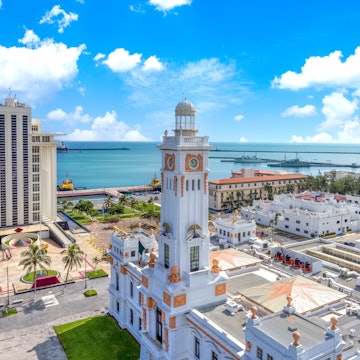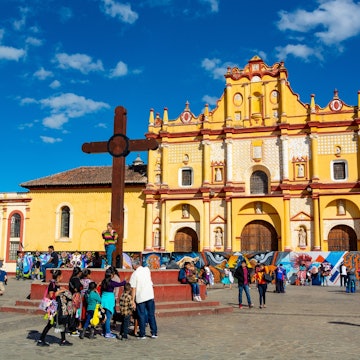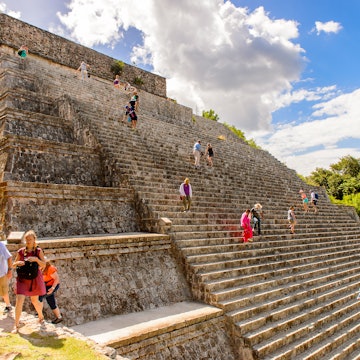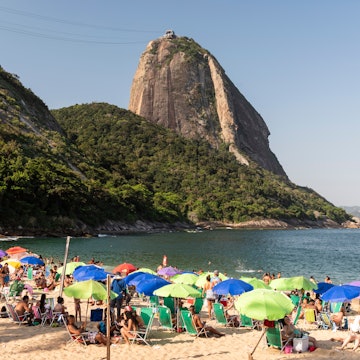
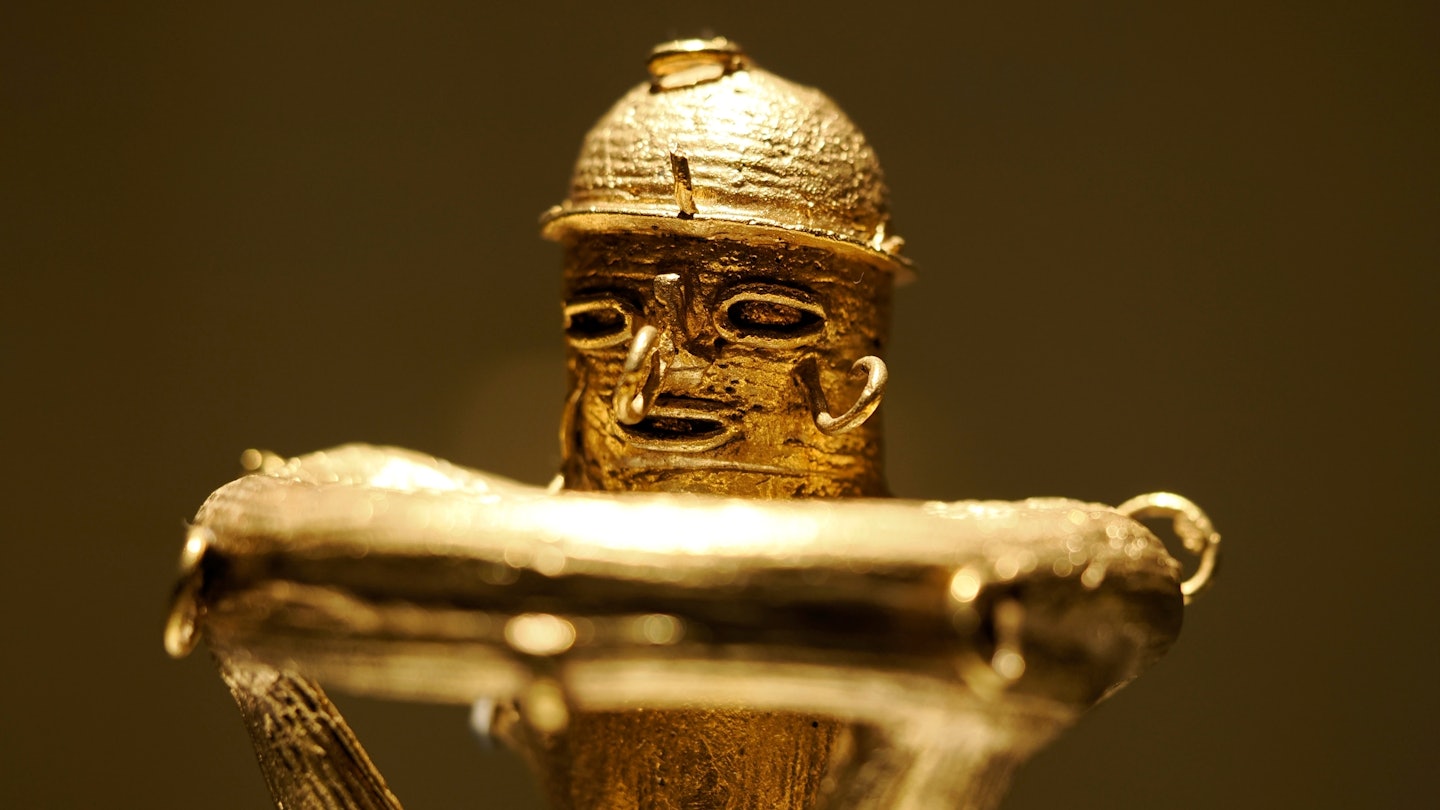
A figurine made of gold on display at the Museo de Oro, Bogotá, Colombia. Andrea Izzotti/Shutterstock
Historic streets, mountain trails, intriguing markets and one-of-a-kind museums are all highlights of Colombia’s capital city, located 2600m (8530ft) above sea level.
In Bogotá, you can start your day with a walk in the local cloud forest, spend your afternoon meandering through the 18th-century streets of La Candelaria neighborhood, then conclude with dinner at a restaurant that becomes a raucous dance club.
While this is a busy, sprawling city of 8 million, the main sites are located just a short taxi ride or even walk apart – a dream for visitors. Make the most of your visit with our picks of the best things to do in Bogotá.
1. Admire stupendous, centuries-old jewelry at the Museo del Oro
Though Colombia’s Indigenous people didn’t construct massive pyramids like their peers in Mexico or Peru, they were dazzling artists on a much smaller scale, producing exquisite gold and bronze jewelry and other other objects.
At the Museo del Oro in central Bogotá, hundreds of earrings, nose plates, necklaces, breastplates and small sculptures depicting birds and mammals provide a window into life in Colombia before the arrival of European colonizers.
The museum is run by Colombia’s Central Bank, which started the collection in 1938 and has since gathered more than 34,000 gold items from the pre-Columbian era, making this one of the world’s largest collections of gold artworks.
The first item purchased by the museum can be found on the fourth floor: a poporo (a golden gourd topped by four spheres). Indigenous people would store lime in these gourds, then mix it with coca leaves while chewing on the sacred plant.
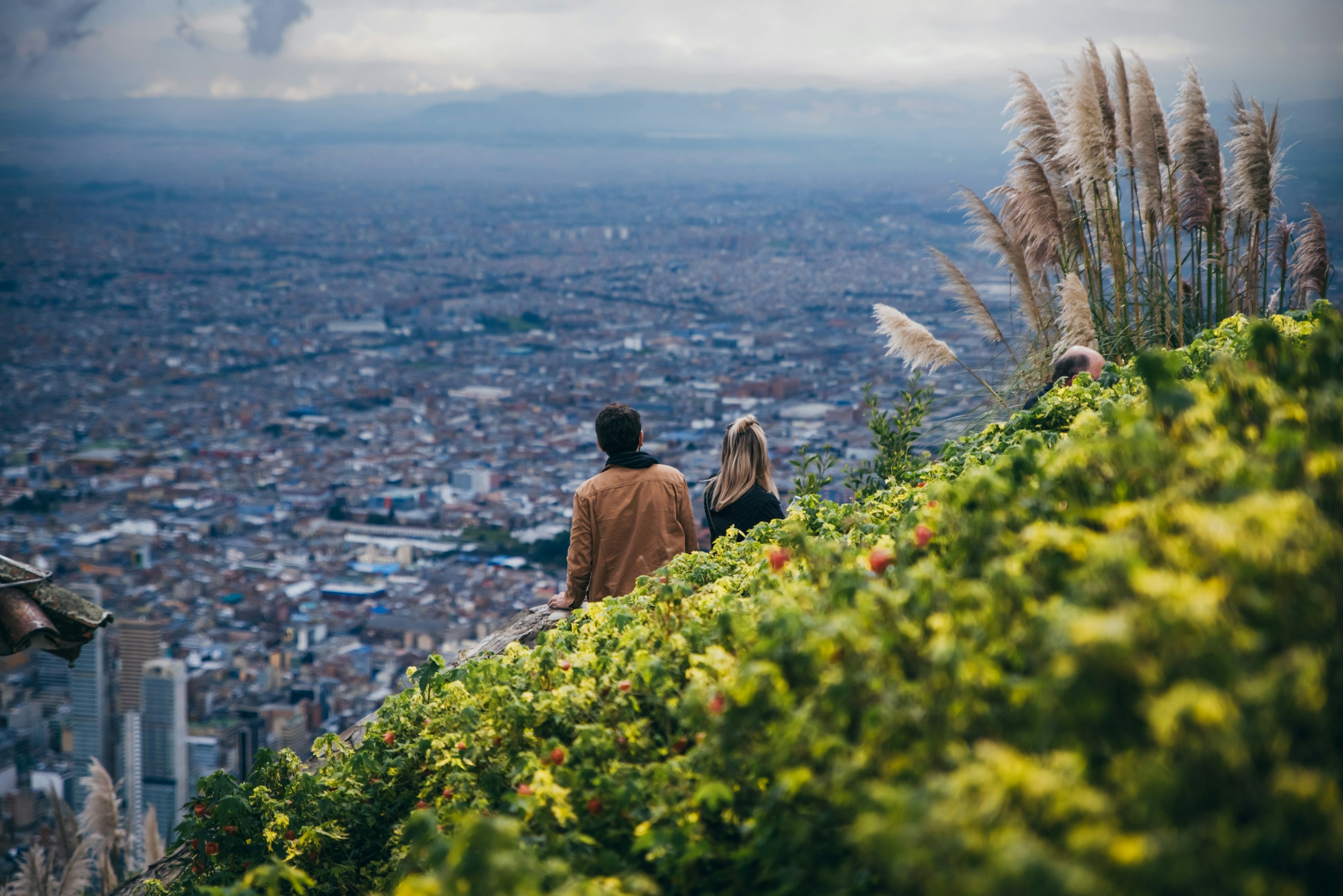
2. Get a bird’s-eye view of Bogotá at Cerro de Monserrate
Ascending the green mountain that towers above the city center affords a view of Bogotá’s dizzying sprawl. Yet high above it all, you’ll be able to breathe fresh air from the cloud forest on its slopes, and nibble on some local treats.
Most people take a cable car to the top of Monserrate. But if you're up for the challenge, there’s a well-marked trail with hundreds of steps that takes about an hour (and some exertion) to complete. Once you’re at the top, you can stroll through market stalls selling souvenirs, coca tea, arepas and fruit juices, as well as hearty lunch and breakfast platters.
Several gourmet restaurants offer panoramic views of the city, while a hilltop church is visited by thousands of pilgrims on Sundays (skip the crowds by visiting on a weekday).
Local tip: Arrive early in the morning to avoid the crowds at the cable car stop. The best times for photos are before 8am, when the sun rises over the mountains behind you as you face the city, or after 5pm, when the sun begins to set over Bogotá.
3. Try a game of tejo in Barrio San Felipe
Throw back a couple of beers and test your aim as you play tejo, a sport that was born in rural Colombia and has become increasingly popular in Bogotá.
The sport consists of throwing an iron disk at a board that is covered with clay and topped off with small paper triangles packed with gunpowder. Hit one of the triangles in the center of the board...and boom! You get extra points.
While you can find competitive tejo matches, most people do it just for fun. The San Felipe neighborhood has a couple of tejo venues that are easy to get to and popular with locals and visitors, including Tejo La Embajada, which sells craft beers and finger food and turns into a dance party later in the night. You can reserve a tejo lane on their website.
Detour: If you visit one of the tejo spots in San Felipe, check out the neighborhood’s Parque La Araña, which is lined with trendy cafes and restaurants and several art galleries. It’s a five-minute walk from Tejo La Embajada, at the corner of Calle 75 and Carrera 22.
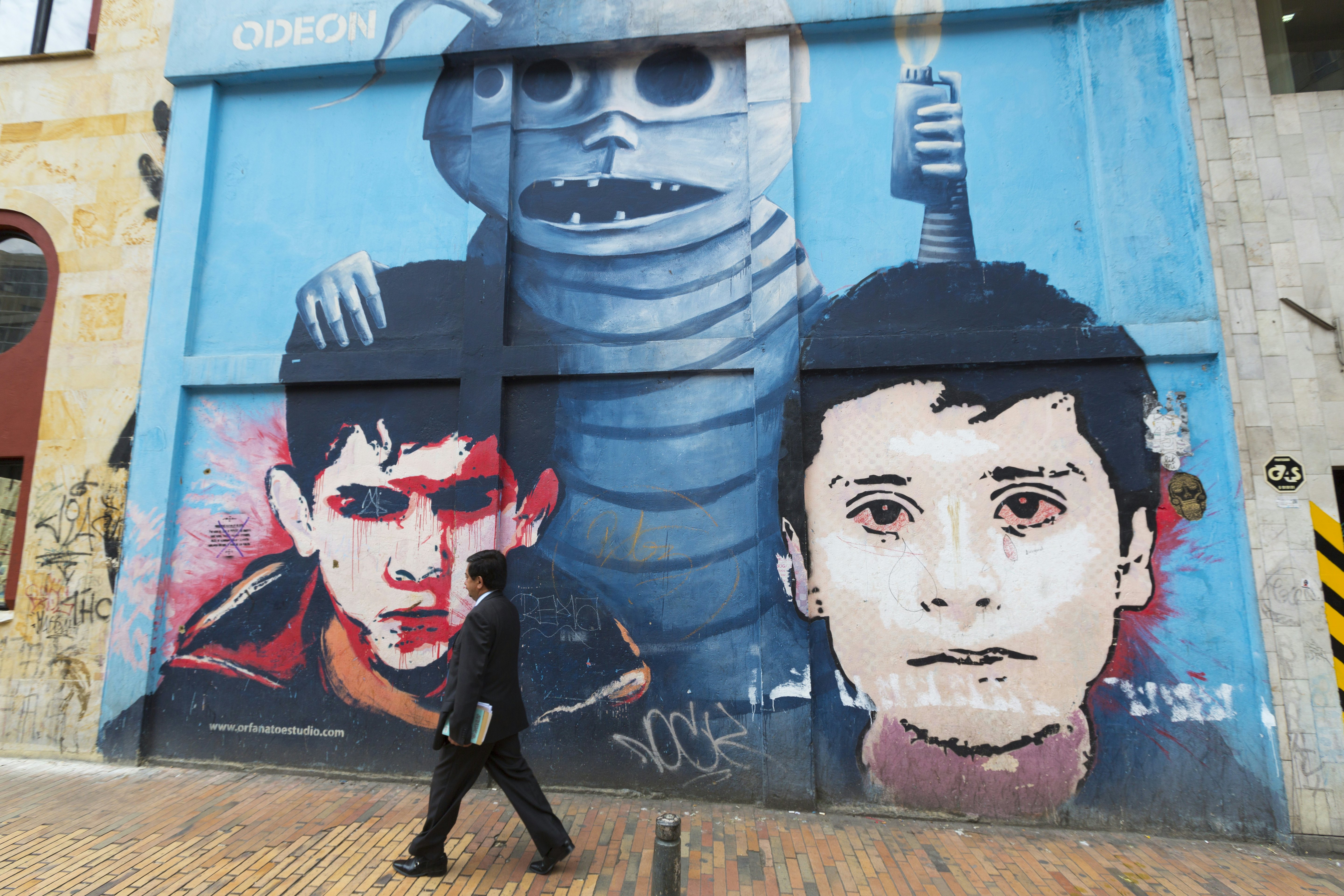
4. Take a graffiti tour to see the modern side of Bogotá’s historical center
Back in 2011, a policeman shot a 16-year-old dead as he sprayed his tag under a bridge. The tragedy unleashed large protests that forced the local government to rethink its approach to urban art.
Bogotá has since decriminalized street art, and now embraces a permissive attitude toward graffiti that has made it easier for artists to decorate the city’s walls. One of the best places to see this eclectic mix of urban art is the historic neighborhood of La Candelaria, where artists offer walking tours of the murals.
Check out Guache’s colorful pieces depicting indigenous motifs, the anti-capitalist stencils of the Toxicomano collective, or Pez’ ubiquitous smiling fish. Some of these colorful murals cover the walls of 18th-century homes that have large windows and clay roof tiles, making for an only-in-Bogotá mix of old and new.

5. Take a stroll through La Candelaria, Bogotá’s historic district
Wandering narrow streets lined with colorfully painted, clay-tile-roofed homes is the best way to get to know La Candelaria, one of Colombia’s best-preserved colonial-era neighborhoods. Start out at Plaza de Bolívar, where you can see the neoclassical Congress building, the baroque-era cathedral and the modern Supreme Court building. Then walk toward the mountains along steep Calle 11, along which you’ll find local art shops, restaurants selling tamales and hot chocolate, and the circle-shaped Gabriel Garcia Marquez cultural center, where the terrace provides a good view over the neighborhood.
La Candelaria is also home to the Museo Botero and El Chorro de Quevedo, Bogotá’s original public square. Many houses in the neighborhood have been converted into coffee shops and bars frequented by students; on weekends, buskers play live music in the streets.
Detour: For a unique culinary experience, try Prudencia on Carrera 2. The restaurant is located in a former 19th-century home and offers an elaborate tasting menu featuring meats that are carefully cooked in a firewood oven. But make sure you get there on time – Prudencia only opens at noon, with the final seating at 4pm.
6. Trek through the cloud forest that carpets Bogotá’s Cerros Orientales
If you’re tired of Bogotá’s hustle and bustle, head to the mountains on the eastern edge of the city, where you can walk along several trails that cross the quiet cloud forest.
Currently, five trails are open to the public. All are free of charge, including Quebrada La Vieja, which starts just a 15-minute walk from the financial district on Calle 72 and will lead you to a viewpoint where you can appreciate the northern half of the city.
The cloud forest itself teems with eucalyptus trees, pines, ferns and local bird species. It’s a favorite spot for locals trying to get some exercise in the mornings, or just seeking a respite from the noise of the city.
Local tip: Run by Bogotá’s water company, EAAB, the trails open only in the mornings, and you must visit EAAB’s website to book a spot. Try to visit on a weekday, as the weekend slots are in high demand.

7. Visit the Museo Botero for a unique take on modern art
Fernando Botero – who died in 2023 at age 100 – is not your typical 20th-century artist. While his peers experimented with cubism or more-abstract forms, Botero’s work celebrates life with lively colors and round, voluminous figures with tiny eyes and delicate hands.
You can check out some of Botero’s most famous paintings and sculptures at the Museo Botero, which is located inside a stately historical building in La Candelaria. As you wander through its galleries, you’ll notice how Botero even manages to make fruits, trees, birds and musical instruments look large, round, lively and...fat, even.
Botero donated more than 120 sculptures and paintings to the Colombian government so that the museum could be built. He also threw in dozens of paintings that he had acquired for his private collection, including works by Picasso, Degas, Renoir and Monet.
Detour: Adjacent to the Museo Botero is building that contains the Banco de la Republica’s art collection, including works by 20th-century Colombian artists like Enrique Grau and Alejandro Obregón. Room 5 has an interesting exhibit on Colombia’s armed conflict produced by photographer Jesús Abad Colorado.
8. Join the late-night crowd at Theatron, Colombia’s most raucous nightclub
At Theatron, you can dance to Cher and Abba under a giant disco ball in this former movie theater–turned–club, then spend the night wandering between 17 other rooms where DJs also spin reggaeton, Latin music, electronica and Gothic trance.
The massive five-story hot spot has long been the prime party spot for Bogotá’s LGBTIQ+ community, and it describes itself on Instagram as “the largest gay-themed night club in Latin America.” Yet it’s also becoming increasingly popular with straight folks who don’t want to miss out on the fun.
There are drag shows on weekends – usually in the room modeled after a Mexican cantina. Theatron can fit up to 6000 people, and goes later than most dance clubs in Bogotá.
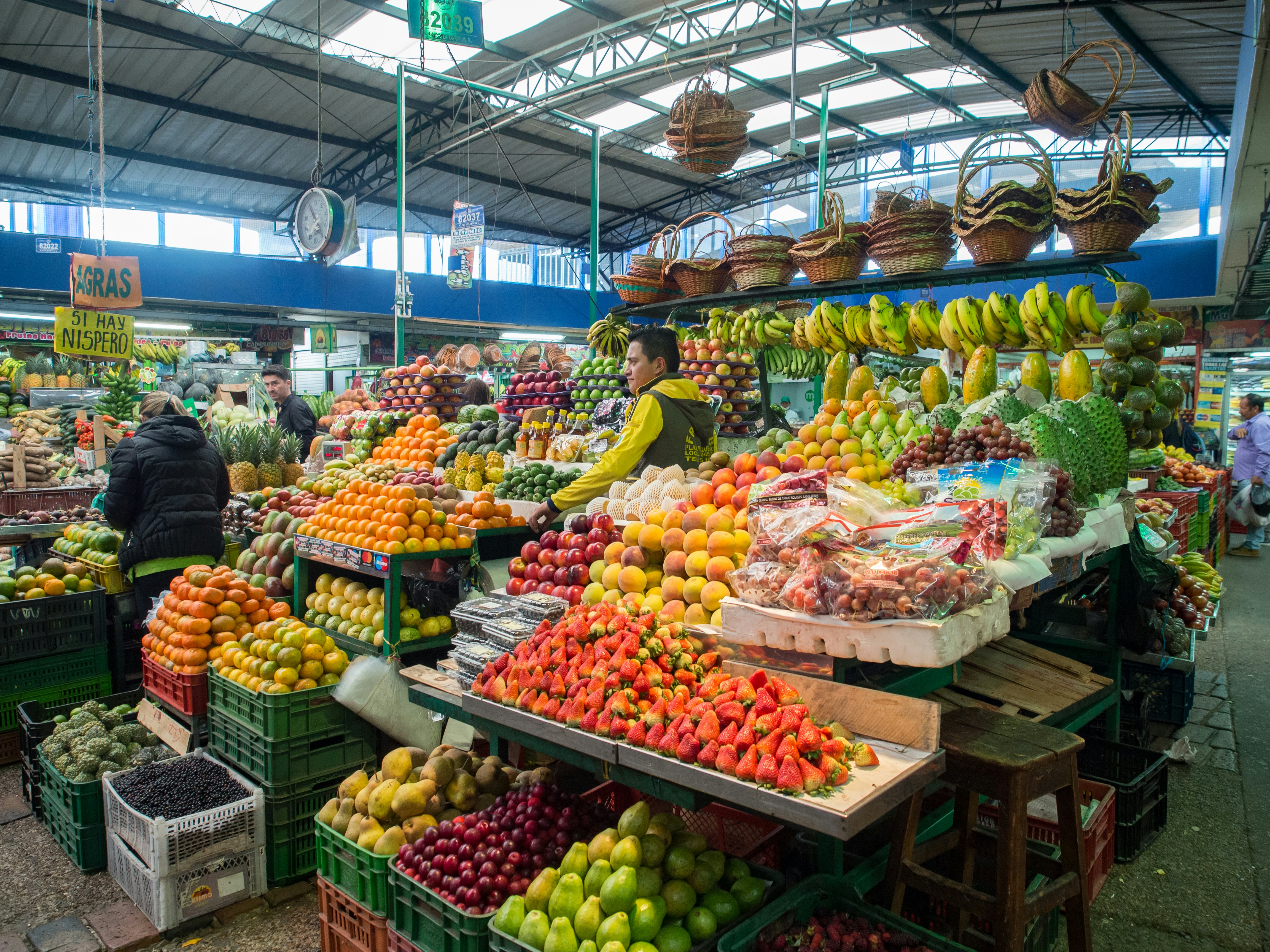
9. Go on a tropical-fruit safari at Mercado Paloquemao
This massive market to the west of the city center receives fresh produce from around the country each day. Take a walk through its busy corridors and spend a few pesos tasting brightly colored tropical fruits with names like lulo, guanabana and pitahaya. Try the crunchy yet refreshing seeds of the granadilla, or go for the sweet pulp of the mangostino, a fruit that is purple on the outside and white inside.
Thirsty? Hit the juice stands and get a smoothie made with curuba, an acid fruit from Colombia’s highlands, or try zapote juice from the Caribbean coast.
The market gets busy on weekends, when families do their grocery shopping and haggle with the stall owners to lower prices. For a quieter experience, visit on weekdays.
Local tip: Breakfast stands at the market also sell local favorites like the changua egg soup, pork, and chicken tamales.

10. Hit the dance floor at one of Bogotá’s salsa clubs
Bogotá’s weather can get chilly, but that doesn’t mean its residents are strangers to tropical rhythms. You can see locals busting their best moves at one of the city’s salsa clubs, where people of all ages and expertise levels dance to tunes by Grupo Niche, Celia Cruz and Hector Lavoe.
In the center of the city, check out El Goce Pagano, where DJs have been spinning old salsa tunes from Cuba, Colombia and beyond for the past three decades. For live acts, make sure to stop by Quiebra Canto, a Bogotá musical institution that has hosted local salsa, champeta and tropical pop bands before they hit it big.
In the north of the city, near Parque 93, Galeria Café Libro also hosts live bands. For a smaller, more intimate feel, try Sandunguera near Plaza Lourdes, which also does lessons early in the evenings.
11. Try Colombian comfort food – then dance off the calories – at Andres Carnes de Res
With its lively music, over-the-top decor and hearty plates, Andres Carne de Res has become the place to go for bogotanos celebrating their birthdays, seeking a loud night out and showing off Colombian culture to visitors from abroad.
At the chain’s Bogotá location, you can try pizza made from fried plantain, then wash it down with a tangerine vodka cocktail known as the Mandarino. Or go for a locally brewed beer accompanied by portions of pork rinds, sweet corn arepas and chorizos with lime. The three-story restaurant turns into a dance club at night, with DJs belting out Latin pop favorites and rock – all, naturally, en español.

12. Rent a bike and explore the city during the Sunday Ciclovía
On Sunday mornings, cars are banned from many of Bogotá’s main roads so that they can be enjoyed exclusively by pedestrians and cyclists.
This weekly ritual is known as the Ciclovía, and it gives residents a good excuse to exercise, enjoy the fresh air and experience the city in a family-friendly atmosphere. It also makes it easier to explore Bogotá on two wheels, without the need to dart in and out of traffic. So rent a bike, strap on a helmet and join the crowd to see some of the city’s sights and stop at fruit-juice stands along the way.
For the duration of the weekly Ciclovía, cars are banned from more than 100km (62 miles) of roads – including Carrera Septima, which connects the historical center with Usaquén and passes through the trendy neighborhoods of Chapinero and Rosales.
Detour: If you want a physical challenge, head toward the municipality of La Calera and join dozens of amateur riders along a windy mountain road that provides sweeping views of the city. The steep climb to La Calera starts on Carrera Septima with Calle 85. Most cyclists stop at the Los Patios toll booth at km 7, where restaurants and food stands provide a rewarding meal.
13. Explore trendy Usaquén and go shopping at its crafts market
The quaint neighborhood of Usaquén buzzes with activity on weekends as dozens of artisans set up small stalls on its narrow streets and sell all manner of goods.
At Usaquén’s craft market, you can get gold-plated earrings in the shape of toucans, colorful hand-painted mugs, wooden carvings of Colombian hummingbirds and skin-care products made from Amazonian fruits.
There are dozens of trendy restaurants in the neighborhood when you're ready to take a break from shopping, as well as a rum bar and a coffee shop that roasts its own grains.
Detour: To see the work of local designers, check out the Ambardae market, located inside one of the neighborhood’s colonial-era homes. You might leave with a hand-stitched sweater or matching pajamas for you and your pets.










